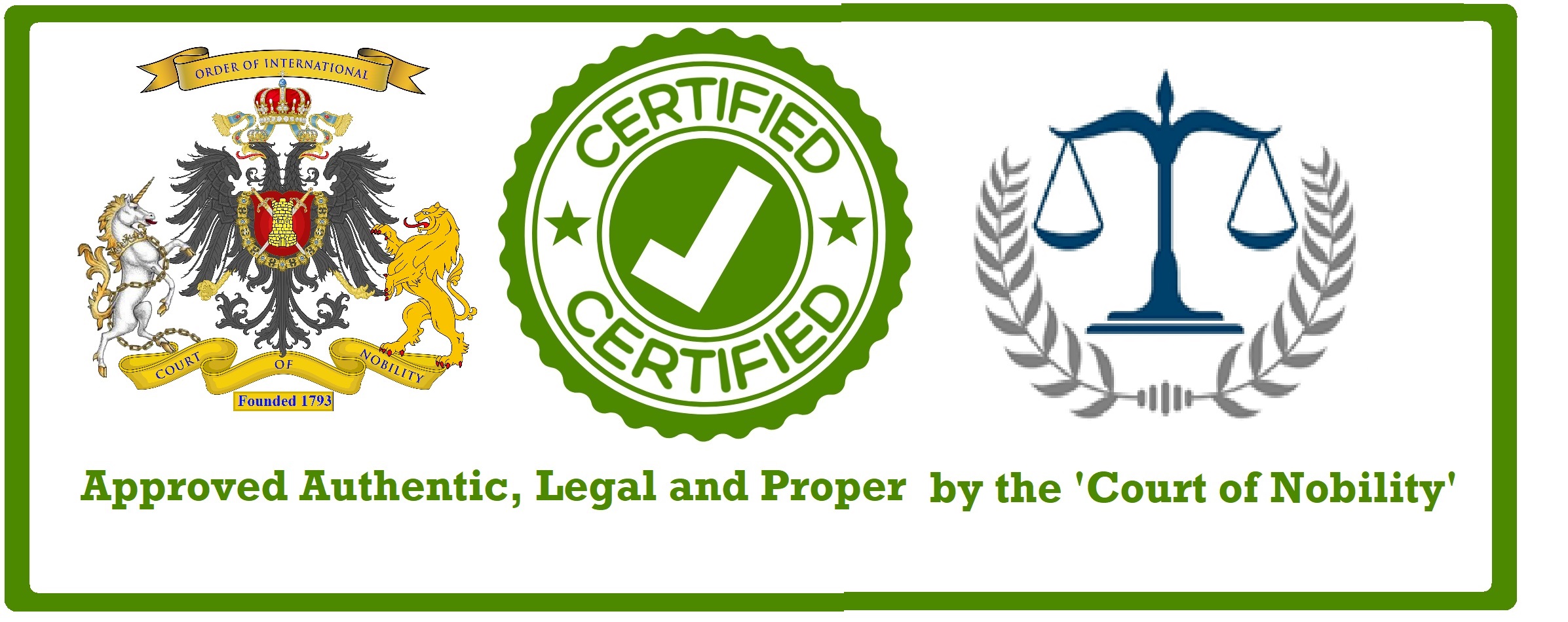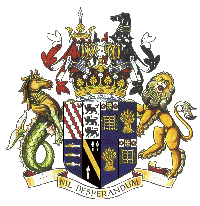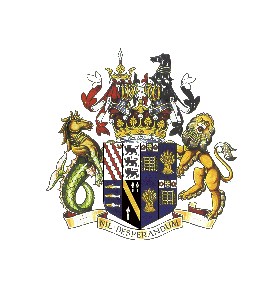This title has been certified by the 'Court of Nobility' to be authentic legal and proper, and comes with the Court of Nobility 'Certificate of authenticity'. Court date: 1st September 2022

TITLE ADDRESS
Baron/Baroness (your name) of Frankia or Francorum
or
Baron/Baroness (your name) Charlemagne de Francorum
 GRANTED BY PRINCE FRANKS descendants of the FRANKS Merovingian Charlemagne dynasty.
GRANTED BY PRINCE FRANKS descendants of the FRANKS Merovingian Charlemagne dynasty.
The Franks or Merovingian dynasty. 481-843
FRANCIA – Latin (Now France)
|
Government |
Monarchy |
|
|
|
|
• 481–511 |
|
|
• 613–629 |
|
|
• 629–639 |
|
|
• 751–768 |
|
|
• 768–814 |
|
|
• 814–840 |
|
Rulers of France, parts of Germany, Netherlands and Austria.
His Royal Highness Prince Franks is of direct descendant to the kings of the Franks and as such has inherited “Fons Honurum” (the right to grant Titles of Nobility).
Mythological origins
Apart from the more respected History of the Franks by Gregory of Tours, two more colourful early sources that describe the origin of the Franks are a 7th-century work known as the Chronicle of Fredegar and the anonymous Liber Historiae Francorum, written a century later.
The author of the Chronicle of Fredegar claimed that the Franks came originally from Troy and quoted the works of Vergil and Hieronymous, and the Franks are mentioned in those works, by Hieronymous.[17] The chronicle describes Priam as a Frankish king whose people migrated to Macedonia after the fall of Troy. In Macedonia, the Franks then divided. The European Franks reached Francia under King Francio, just as Romulus went to Rome. Another branch, under King Turchot, became the Turks. Fredegar stated that Theudemer, named king of the Franks by Gregory, was descended from Priam, Friga and Francio.
Another work, the Gesta, described how 12,000 Trojans, led by Priam and Antenor, sailed from Troy to the River Don in Russia and on to Pannonia, which is on the River Danube, settling near the Sea of Azov. There they founded a city called Sicambria. (The Sicambri were the most well-known tribe in the Frankish homeland in the time of the early Roman empire, still remembered though defeated and dispersed long before the Frankish name appeared.) The Trojans joined the Roman army in accomplishing the task of driving their enemies into the marshes of Mæotis, for which they received the name of Franks (meaning "savage"). A decade later the Romans killed Priam and drove away Marcomer and Sunno, the sons of Priam and Antenor, and the other Franks.
The Merovingian dynasty was the ruling family of the Franks from the middle of the 5th century until 751. They first appear as "Kings of the Franks" in the Roman army of northern Gaul.
Titles that can be granted
Prince & Princess £180,000
Duke & Duchess £140,000
Marquis & Marchioness £120,000
Count & Countess £100,000
Baron & Baroness £80,000
Sir & Dame £70,000
The Merovingian kingdoms at their height
The Merovingian dynasty was the ruling family of the Franks from the middle of the 5th century until 751.[1] They first appear as "Kings of the Franks" in the Roman army of northern Gaul. By 509 they had united all the Franks and northern Gaulish Romans under their rule. They conquered most of Gaul, defeating the Visigoths (507) and the Burgundians (534), and also extended their rule into Raetia (537). In Germania, the Alemanni, Bavarii and Saxons accepted their lordship. The Merovingian realm was the largest and most powerful of the states of western Europe following the fall of the Western Roman Empire.
The term "Merovingian" comes from medieval Latin Merovingi or Merohingi ("sons of Merovech"), an alteration of an unattested Frankish form, akin to their dynasty's Old English name Merewīowing,[2] with the final -ing being a typical Germanic patronymic suffix. The name derives from the possibly legendary King Merovech. Unlike the Anglo-Saxon royal genealogies, the Merovingians never claimed descent from a god, nor is there evidence that they were regarded as sacred.
The Merovingians' long hair distinguished them among the Franks, who commonly cut their hair short. Contemporaries sometimes referred to them as the "long-haired kings" (Latin reges criniti). A Merovingian whose hair was cut could not rule and a rival could be removed from the succession by being tonsured and sent to a monastery. The Merovingians also used a distinct name stock. One of their names, Clovis, evolved into Louis and remained common among French royalty down to the 19th century.
The first known Merovingian king was Childeric I (died 481). His son Clovis I (died 511) converted to Christianity, united the Franks and conquered most of Gaul. The Merovingians treated their kingdom as single yet divisible. Clovis's four sons divided the kingdom between them and it remained divided—with the exception of four short periods (558–61, 613–23, 629–34, 673–75)—down to 679. After that it was only divided again once (717–18). The main divisions of the kingdom were Austrasia, Neustria, Burgundy and Aquitaine.
During the final century of Merovingian rule, the kings were increasingly pushed into a ceremonial role. Actual power was increasingly in the hands of the mayor of the palace, the highest-ranking official under the king. In 656, the mayor Grimoald I tried to place his son Childebert on the throne in Austrasia. Grimoald was arrested and executed, but his son ruled until 662, when the Merovingian dynasty was restored. When King Theuderic III died in 737, the mayor Charles Martel continued to rule the kingdoms without a king until his death in 741. The dynasty was restored again in 743, but in 751 Charles's son, Pippin III, deposed the last king, Childeric III, and had himself crowned, inaugurating the Carolingian dynasty.
History of the Netherlands: The Merovingian Dynasty (481–751)
With the end of Pax Romana in the fifth century, an age of peace had come to an end. What followed was chaos, decline, and bloodshed, as tribes and warlords vied for land and power. It was the age of the great migrations as new peoples invaded the lands of western Europe and tried to push out the natives. The Angles and Saxons began invading the lands of the Frisians. The Frisians themselves used the power vacuum left by the Romans to expand their territory southwards into the riverlands.
The Great Migrations (1st to 5th century)
Clovis I, King of the Franks
Since their first arrival in the 2nd century, the Franks had settled in the region south of the great rivers of the Lower Countries. They were a loose coaltion of various tribes, including the Bructeri, Tencteri, Sugambri, Chamavi, Chatti, and possibly some Batavians. Beginning in the second half of the 5th century, the Franks began moving south to central Gaul. They were ruled by petty warlords who endlessly fought one another for territory and loot, until the Merovingians unified the tribes in the 6th century.
The Baptism of Clovis by Remigius van Reims (16th century)
King Chlodovech (c. 466–511) — to us better known as Clovis I — was the first king of the Franks to unite all of the Frankish tribes under one ruler, changing the form of leadership from a group of royal chieftains, to rule by a single king and ensuring that the kingship was passed down to his heirs. Clovis I was the grandson of Merovech, the founder of the Merovingian dynasty, and he succeeded his father in at the age of fifteen in 481. Five years later he would conquer what was left of the Western Roman Empire and unite all of Gaul. Clovis would then spend most of his life fighting his rivals, and at the end of his reign he converted to Orthodox Christianity as a move to gain support among the growing Christian population of Gaul. The empire which Clovis founded would lay the foundations for the country that we now know as France.
The Realm after Clovis
The realm of the Franks (5th to 9th century)
As per Frankish tradition, the realm of Clovis was divided after his death in 511 among his four sons. It would take over a century before a new king, Dagobert I (c. 603–639), would successfully reunite the Franks again in 629. Dagobert I was however to be the last Merovingian king to wield any real royal power.
The failed baptism of King Radbod
Dagobert I is mostly known in the Lower Countries for being the first to try to convert the Frisians. The Frisians knew that adopting christianity would not just mean a change of faith, but also meant subservience to the Franks. From 650 to 689 the Franks and the Frisians would fight over control of the great rivers in the Lower Countries, until Pepin II would defeat the Frisian king Radbod at Dorestad. Radbod was forced to mary his daughter to a son of Pepin, and he had to tolerate missionary activities in his realm.
King Clovis III (left) and Master Pepin II (right)
Pepin II (c. 635–714) was not a king, nor was he a descendant of Clovis or Dagobert. He was a Majordomo or Master of the Palace. By the end of the 7th century the Frankish Realm had fallen into decay as the power of the Merovingian dynasty declined and local lords started to defy the royal throne. As power of the monarchy receded, it was the Master of the Palace who became the true ruler of the realm.
Pepin II managed to largely restore central authority in most parts of the realm, and his bastard and successor, Charles Martel (688–741), would go on to conquer all the Frisian lands. Charles Martel ended the façade of the Merovingian monarchy and he would divide his realm between his two sons, Carloman and Pepin III. When Pepin III was declared king in 751 and baptised by archbishop Boniface, he had Childeric III — the last of the Merovingians — locked up. Thus the Merovingian dynasty had come to an end.
The Dutch economy under the Merovingians
The Netherlands in the Early Middle Ages
During the chaos of the 5th century, population numbers declined and living conditions detoriated. A rising sealevel was making life hard at the coasts, and the constant plundering by invaders had destroyed much of the infrastructure laid down by the Romans. Not until the 7th century would the population start to grow again as the development of wild land created new opportunities for agriculture and cattle farming.
Early Medieval society was largely rural as the Roman cities had become depopulated. The economy reverted back to a mainly agricultural one, and what remained of trade was largely focussed on local markets, as long-range travel became too dangerous due to bandits and lack of law enforcement. The roads built by the Romans decayed, and most trade was again done by water.
The early medieval trade routes of Dorestad
Dorestad became the the most important economic centre of the Lower Countires as it was part of the north-eastern shipping routes due to its proximity to the fork in the Rhine, which provided access to England, Northern France, the Northern Lower Countries, Northern Germany, and Scandinavia. The economic importance of Dorestad was the reason why the Franks and the Frisians fought for almost forty years over control of the riverlands.
Dorestad in the network of the northern European trade routes of the Early Middle Ages
The main tradware were agricultural products, pottery, clothing, leather, weapons, and tools. From the south came mostly copper and brass products, like cooking pots, buckels, and jewelry.
Feudalism in the Lower Countries
As in the rest of Western Europe, the Southern Lower Countries saw the introduction of feudalism in the Early Middle Ages. As the economy had again become a largely agriculture one, power was based on land ownership. The Frankish king was the most important land owner, and his wealth came from his royal dominions and his treasury. Below him was the free estate of the landowners, who were granted fiefs — borrowed land — by the king to rule over and acted as bannermen for the king. On the dominions of the king and the fiefs of the landowners worked serfs, who also owned their own land, and slaves, who were property of their lords.
The hierarchy of the feudal system
With the decline of central authority and rule of law due to the Roman retreat, personal relations became vital for security and prosperity in the Early Medieval world. The lords swore oaths of fealty to their king, and the serfs did the same to their lords. The Lords would receive fiefs from the king in exchange for becoming his vassal, which came with the promise of military service, support, and allegiance. A serf would promise his servitude to a lord in exchange for his protection. These oaths were for life and often hereditary, and were the glue that held the feudal system together. Hence, breaking an oath to one’s lord was about the worst crime one could commit and the penalties were severe.
A lord places his hands between the hands of the king and pledges his loyalty
Power and administration
The power of the Merovingians declined in the 7th century, as the kings were giving more and more of their dominions to vassals for support. Only on the royal dominions did the king have absolute power. Outside those he had to rely on the support of the local landowners. As the monarchy grew weaker, the commoners came to rely more on the support of their local lords for their protection. Combined with hereditary fiefs, this allowed local lords to build a powerbase which could often rival that of the king’s.
The Merovingian court at the Rhine c. 675 by Paul Becx (2013)
The king’s court was a mobile one and it continuously travelled through the realm from palace to palace. The most important form of taxation was essentially providing a palace with food during the royal court’s stay. As the king stayed in a palace he would act as judge for local cases. The Merovingian kings practised common law as any man was to be judged according to his people’s laws, regardless of where he or she was reciding in the realm. Naturally, different laws applied to the estates of the feudal system.
Enter the Carolingians
As Pepin III was crowned king, so began the Carolingian dynasty. It would build on many of the foundations which had been laid by the Merovingians.

